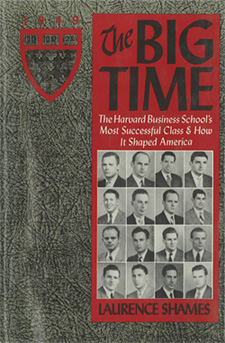Preface to the 2012 Edition

The Big Time was my first non-fiction book; originally published in 1986, it sold better than I thought it would and garnered a good deal more attention than I expected. The work was excerpted in both Esquire and Playboy; it was favorably reviewed in The New York Times and many other publications; it even made Business Week’s ten-best list for the year.
For a new author, this was all very gratifying, and yet I was quite ambivalent about the book’s reception for a reason that, until now, I have mostly kept to myself: I thought it was succeeding, in part at least, for the wrong reasons.
Because the book’s central subject was a class from the Harvard Business School—the famously powerful and accomplished class of 1949—reviewers approached it as a business book, pure and simple. Many readers, it seemed, were drawn to it in hopes of absorbing at least some of the strong magic of a B-School education; others picked it up for a vicarious glimpse into the glamour of the boardroom and the corner office.
Now, it’s not that any of those readings were misguided. Of course The Big Time dealt with real-world business matters. There were plenty of anecdotes involving the dilemmas and maneuvers that sometimes make the workplace a stage for high drama. And the 49ers, both by example and through their remarkably candid interview comments, did in fact reveal a wealth of information about the particular methods and wisdom by which HBS shaped its students. But for all that, I was pretty sure that what I’d written was a small but careful work of social criticism that was being read too narrowly as a how-to-succeed-in-business primer.
Thinking back to the culture of 1986, it was probably inevitable that The Big Time would be viewed that way. Business was regarded as quite sexy in those years. Cheerleading magazines like Success and Manhattan, Inc. were flourishing. The loathsome but ubiquitous term “Yuppie” had recently been coined. The hot career was Management Consulting—whatever that exactly was—and the best if not the only way to get on that track was with an MBA degree, preferably from Harvard. The Internet and the dot-coms hadn’t quite come into being; the nerds had yet to have their day. In 1986, the people—almost all white males—who wielded power and amassed fortunes in the business world tended to be smooth and solid executive types, not rebels or visionaries. They wore dark suits and silk ties; they had the right degrees and the right connections and felt no qualms whatsoever about using them to personal advantage. In short, they knew how to play the game. And no one played it better than the ‘49ers.
However, in writing my first book (which, like every writer, I secretly feared might also be my last) I wanted to do more than just tell entertaining stories about a bunch of rich guys. I wanted to say something. I wanted to examine how a certain group of fortunate characters had chosen to live their lives, and what those choices revealed about our culture.
How did the ‘49ers define personal success? What did they see as the proper balance between ambition and responsibility? If business was a game, what were the implications of playing it the way it was played in mid-twentieth century America? Were we rewarding leaders or only managers, creators or mere shufflers of assets? Had we, in 1986, already grown too comfortable, too smugly secure in our prosperity? Had our business leaders noticed that the world was changing, or were we in some early stage of coasting toward decline? These were the sorts of questions I was trying to address in The Big Time, and I believe they are even more pressing now than on the day of the book’s original appearance.
The decades after World War II were a famously golden era for America. From the perspective of 2012, those confident years seem positively Edenic; but even in 1986 it was impossible to look back at them without nostalgia. In the 1950s and 1960s, the whole world wanted what America had—the cars, the movies, the safe, clean suburbs where an expanding middle class could live in greater comfort than average folks had ever known. But it wasn’t just America’s economic prowess that was the envied around the globe; it was the American spirit—the drive, the optimism, the belief that things were only getting better.
The men of HBS 1949 were emblematic of that spirit; not overly modest, they tended to see themselves as its stewards. To be sure, their generation also faced its challenges, its threats to certainty. The emergence of Japan in the 1970s led to a questioning and a crisis of morale not so different from that occasioned by the more recent rise of China. In their time, too, there were recessions and bubbles; the Crash of ’87 was just around the corner as this book was being published. Some of the more thoughtful ‘49ers were already wondering aloud if American dominance and growth could be sustained, and how life would be different for generations born into less sanguine and expansive times.
If the ‘49ers had been mere observers of the culture around them, their story would still be worth the telling. In fact, though, this remarkable group of men did far more than observe; by dint of their wealth, power, and sheer determination, they did much to shape America–the wealthy, sometimes arrogant, energetic and unequal America that later generations have now inherited. In offering The Big Time to a new audience, my hope is not merely to present a portrait of what seems, increasingly, a faraway time, but to promote a deeper and more nuanced understanding of our own.
LS
Ojai, California 2012